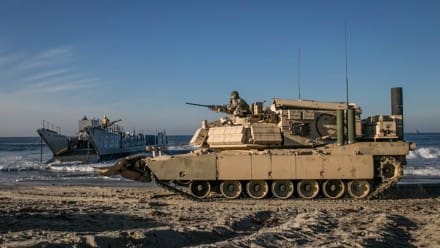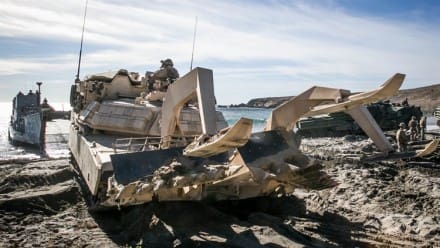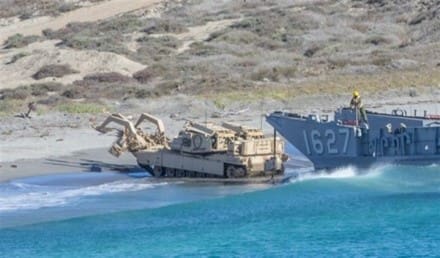MARINE CORPS BASE QUANTICO, Va. —
The Marine Corps’ Assault Breacher Vehicle made history last year when it conducted its first amphibious landing with a Modified Full Width Mine Plow prototype during a long-range breaching exercise in the western United States.

U.S. Marines from 1st Combat Engineer Battalion, 1st Marine Division, prepare to load an Assault Breacher Vehicle onto a Landing Craft Utility at Camp Pendleton, California. All vehicles were loaded onto LCUs then transported to the USS Rushmore to conduct the first amphibious landing in an ABV with a Modified Full Width Mine Plow prototype. Marine Corps Systems Command tested the prototype which will make it easier to transport the ABV from ship to shore. (Courtesy photo)
In December 2017, Marine Corps Systems Command used Exercise Steel Knight as an opportunity to test the Modified Full Width Mine Plow prototype for the first time. Steel Knight is a division-level exercise designed to enhance command and control, and interoperability with the 1st Marine Division, its adjacent units and naval support forces.
In the future, this piece of equipment will make it easier for Marines to land and deploy an ABV from a Navy Landing Craft Utility boat to the shore to complete their mission.

U.S. Marines from 1st Combat Engineer Battalion, 1st Marine Division, conduct the first amphibious landing in an Assault Breacher Vehicle with a Modified Full Width Mine Plow prototype during Exercise Steel Knight on the west coast. Marine Corps Systems Command tested the prototype which will make it easier to transport the ABV from ship to shore. (U.S. Marine Corps photo by Lance Cpl. Rhita Daniel)
“Our legacy Full Width Mine Plow on the ABV could not fit onto an LCU because it was too wide,” said Timothy Barrons, ABV project officer for Engineer Systems at Marine Corps Systems Command. “The prototype we are testing fills a current capability gap and gives commanders the flexibility to use multiple surface connectors to get ABVs in the fight.”
The modified plow prototype is not only easier to transport, but safer to use, Barrons said. Once the LCU drops the bow ramp onto land, Marines can drive the ABV off the boat, open the plow and breach the area to ensure they eliminate any unsafe obstacles.
“The Assault Breacher Vehicle is the premiere breaching tool in the Marine Corps, and there is no other tool like it,” said Alvin “Tommy” West, ABV platform engineer. “It can carry two Linear Demolition Charges (commonly referred to as the line charge) on the back with over a thousand pounds of C4 explosives in each of the charge. A rocket is attached to each line charge to propel the charge, which is critical when clearing a path through mine fields.”

U.S. Marines from 1st Combat Engineer Battalion, 1st Marine Division, conduct the first amphibious landing in an Assault Breacher Vehicle with a Modified Full Width Mine Plow prototype during Exercise Steel Knight on the west coast. Marine Corps Systems Command tested the prototype which will make it easier to transport the ABV from ship to shore. (Courtesy photo)
After the line charge detonates, landmines in its path are destroyed or rendered ineffective. Marines use the mine plow to sift through the mine field and push any remaining landmines off to the side, leaving a safe path for the assault force.
“This plow prototype makes the ABV transportable and gives the commander options to accomplish his tasks on the battlefield,” said Barrons. “The capability makes the force more lethal because it helps keep other combat vehicles intact and saves the lives of Marines.”
The ABV Program Team plans to take the information and feedback from Marines gathered at Steel Knight to refine the design and improve the overall performance of the modified plow. The team wants to ensure the modified plow will meet all requirements of the legacy mine plow in performance and survivability. After the redesign is completed, the articles will be tested at the U.S. Army Aberdeen Test Center in Maryland.
“Because the plow is foldable and deals directly with explosives, it is going to take some hits, so we need to ensure it is more reliable than the legacy mine plow which was not hinged or foldable,” said West. “There is no other piece of gear in the Marine Corps that does what the ABV with the Full Width Mine Plow does. Our goal is to make the new plow even more reliable and easier to maintain.”
The ABV Program is a part of Engineer Systems under the Logistics Combat Element Systems program at Marine Corps Systems Command.
By Kaitlin Kelly, MCSC Office of Public Affairs and Communication | Marine Corps Systems Command


Implementing the ABV into the first stages of an amphibious assault would be incredibly useful to any follow on dismounted Infantry. The frontal armor could easily soak up anything the beach defenses could throw at it and the on-board MCLC would act as an enourmous Bangalore, clearing any mines, wire, obstacles, and enemy fortifications in its path. Adding flamethrowers would make it even better, or the cannon from the old CEV, but it seems more than able to meet the task at hand.
And yet the AF claims there is no way to mount a plow on a MATV.